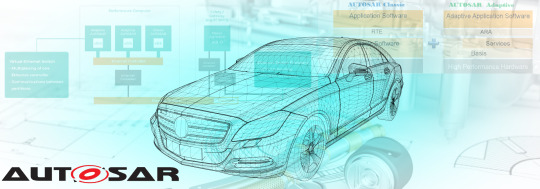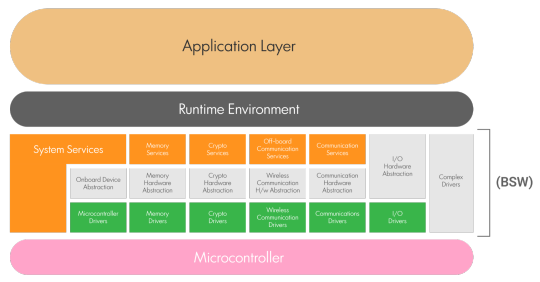#Classic and Adaptive AUTOSAR
Text
Top Classic and Adaptive AUTOSAR solutions in India- KPIT
KPIT providing the Top Classic and Adaptive AUTOSAR solutions in India, With 15+ years of AUTOSAR experience, KPIT offers AUTOSAR Base Software Solutions that go across E/E Architecture, such as High-Performance Compute (HPC) Platforms, Real-Time Critical ECUs, Sensors and I/O Concentrators, visite here to know more.
#AUTOSAR Solutions#AUTOSAR Base Software Solutions#Classic and Adaptive AUTOSAR#Software Integration Services#Platforms and Tools#AUTOSAR architecture#automotive industry#automotive and mobility industry
0 notes
Text
Classic AUTOSAR and Adaptive AUTOSAR Design Services

AUTOSAR or Automotive Open System Architecture is a systematized automotive software architecture, which keeps order in interfaces between application software and basic vehicular functions and it aids in creating common ECU software architecture for all the AUTOSAR members.
AUTOSAR is expected to dispense intrinsic advantages to the members to control gradually more complex E/E in-vehicle environments like simple incorporation and exchange of functions in complex ECU networks and control over the entire product lifecycle.
The AUTOSAR standard defines variations of the software architecture called AUTOSAR platforms: Classic AUTOSAR Platform and Adaptive AUTOSAR Platform.
AUTOSAR Architecture
AUTOSAR is a growing and evolving standard that defines a layered architecture for the software. The classic AUTOSAR platform runs on a microcontroller and is divided into 3 main layers
Basic Software Architecture (which is common for any AUTOSAR ECU and runs on a Microcontroller)
AUTOSAR Runtime Environment Layer (RTE Layer)
Application Layer
Basic Software Architecture (which is common for any AUTOSAR ECU and runs on a Microcontroller)
AUTOSAR Runtime Environment Layer (RTE Layer)
Application Layer
The AUTOSAR Basic Software (BSW) is further divided into three layers:
1. Services Layer,
2. ECU Abstraction Layer,
3. Microcontroller Abstraction Layer (MCAL)

1. Services Layer
The service layer is the topmost layer of AUTOSAR Basic Software Architecture.
The service layer propounds
An operating system, which runs functionally from the application layer to the microcontroller at the bottom.
Vehicle network communication and management services
Diagnostic Services (Unified Diagnostic Services, Error handling and Memory)
Memory services (Non Volatile RAM)
ECU state management
Logical and temporal program flow monitoring
An operating system, which runs functionally from the application layer to the microcontroller at the bottom.
Vehicle network communication and management services
Diagnostic Services (Unified Diagnostic Services, Error handling, and Memory)
Memory services (Non-Volatile RAM)
ECU state management
Logical and temporal program flow monitoring
2. ECU Abstraction Layer
ECU Abstraction Layer l and its drivers are independent of the microcontroller and dependent on the ECU and interface the drivers of the Microcontroller Abstraction Layer (MCAL).
ECU Abstraction propounds
Access to all the peripherals and devices of ECU, which supports functionalities like communication, memory, I/O, etc.
3. Microcontroller Abstraction Layer (MCAL)
The Microcontroller Abstraction Layer (MCAL) also known as a hardware abstraction layer is the lowest layer of the Basic Software.
MCAL contains internal drivers which are software modules that are direct access to the µC and integrated with the microcontroller through registers and offers drivers like system drivers, diagnostics drivers, memory drivers, communication drivers (CAN, LIN, Ethernet, etc.), I/O drivers, and more.
RTE Layer
RTE Layer is a middleware layer of the AUTOSAR software architecture between the BSW and the application layer and provides communication services to the application software for example AUTOSAR Software Components and/or AUTOSAR Sensor/Actuator components.
Application layer
The application layer is the topmost layer of the AUTOSAR software architecture and supports custom functionalities implementation. This layer consists of the specific software components and many applications, which are a group of interconnected AUTOSAR Software Components and perform specific tasks as per instructions.
The AUTOSAR application layer consists of three components which are: application software components, ports of software components, and port interfaces. Depending on the requirements of the application an AUTOSAR Software Component might be a small, reusable piece of functionality such as lane-keeping assistance, Wiper Control, Automatic door unlocks, etc.

AUTOSAR Services by Faststream Technologies
Faststream Technologies partnering with AUTOSAR helps the automotive OEMs and tier 1 suppliers in many AUTOSAR related solutions like development, integration, and validation of AUTOSAR basic software modules. We integrate the AUTOSAR stack software from tool suppliers and upgrade platform software to new AUTOSAR versions as per specifications and more.
Classic AUTOSAR
Implementation of our Classic AUTOSAR basic Software:
Highlights
• Efficient and scalable AUTOSAR-compliant and OSEK/VDX compliant products for ECUs
• Full AUTOSAR support with one basic software stack, and one tool environment
• Safe and ready for series production
• Single-/multi-core operating systems
• Tailor-made products, services, and support Benefits
• Highest safety levels
• Time and cost savings through reusable software functions
• Safe, and reliable mass production-ready software
Benefits
• Highest safety levels
• Time and cost savings through reusable software functions
• Safe, and reliable mass production-ready software
Adaptive AUTOSAR
Our Product Line
AdaptiveCore
An adaptive platform for safe and secure applications
Hypervisor
Micro-kernel-based hypervisor to run multiple (different) operating systems on one single CPU Adaptive platform for safe and secure applications
Linux
Container-based Linux distribution
Faststream’s solution
Integrated development environment for the AUTOSAR products
Faststream’s Software infrastructure for high-performance controller
Highlights
• Applicable for all domains: infotainment, highly automated driving, etc.
• Modular architecture, flexible configuration of building blocks
• Possibility to add new functions through updates
• Hardware agnostic (ARM, Intel, NVIDIA, etc.)
• Adaptive AUTOSAR based software stack
Benefits
• One-stop-solution for safe and secure high-performance computing
• Pre-integrated software modules save time and costs
• Prepared for operations of software infrastructure for 5+ years
#autosar#fleet management system#fleet management software#fleet management solution#adaptive autosar#classic autosar#automobiles
0 notes
Text
AUTOSAR Integration/development Engineer, Job For 0-50 Year Exp In Luxoft Bengaluru / Bangalore, India - 3732516
AUTOSAR Integration/development Engineer, Job For 0-50 Year Exp In Luxoft Bengaluru / Bangalore, India – 3732516
DescriptionDevelopment and Maintenance of generic software modules for both classic AUTOSAR and adaptive AUTOSAR. These modules are integrated into 30+ ECUs from different Tier1 & TIer2s with different stacks to run a OEM specific diagnostics and enhanced functionalities on top of AUTOSARWe are providing expert AUTOSAR solutions to our client in the following areas: Ethernet Diagnostics, Remote…
View On WordPress
0 notes
Text
KPIT providing the Top Classic and Adaptive AUTOSAR solutions in India, With 15+ years of AUTOSAR experience, KPIT offers AUTOSAR Base Software Solutions that go across E/E Architecture, such as High-Performance Compute (HPC) Platforms, Real-Time Critical ECUs, Sensors and I/O Concentrators, visite here to know more.
#AUTOSAR Solutions#AUTOSAR Base Software Solutions#Classic and Adaptive AUTOSAR#Software Integration Services#Platforms and Tools#AUTOSAR architecture
0 notes
Text
SOFTWARE DEVELOPMENT & INTEGRATION PARTNER FOR BODY, GATEWAY & HIGH-PERFORMANCE COMPUTE PLATFORMS
KPIT provides comprehensive solutions for Vehicle Body & Gateway from concept development to maintenance for current & next generation programs
AUTOSAR Stack Integration
High Performance Compute – HPC & Zonal Architecture
Multicore Architecture
Future Technologies
Application Migration and Integration
Functional Safety
Cyber Security
Virtual Validation
Body electronics - Offerings
SDV Programs

Body System Engineering Services

Application Development & Integration Services

Body Features Validation Service
High-Performance Compute (HPC) Application
Zonal ECUs
System Architecture Definition (SoA + signal based) and Specification development
EE architecture and System model using PREEVision, MagicDraw, Rhapsody, EA
ISO 26262 based Functional Safety analysis (HARA, DFMEA)
Cyber security TARA analysis
System Architecture Definition (SoA + signal based)
Application Migration strategy definition for Classic/Adaptive SWCs
Application and Feature development in MBD/CBD
End-to-end Body feature software integration
Multidomain Feature Integration in HPC and Zonal ECUs
Model based Testing (MIL, SIL)
Plant model development for Body features
Body Virtual Validation Platform development
HIL testing of different Body features & Test Automation using dSPACE, Vector & KPIT Solutions (Technica)
Vehicle Testing and Calibration
Single Function ECU
Architecture re-design of legacy system based on new SDV systems
Migration of legacy system requirement to Model based system engineering
Application and Feature development in MBD/CBD
Body software Model based Testing (MIL, SIL and PIL)
Body Virtual validation platform development with standalone ECUs
#Body electronics#Body System Engineering Services#Application Development & Integration Services#Body Features Validation Service#SDV programs#vehicle body and gateway solutions#Body & Gateway software development#Body Gateway Module#automotive
0 notes
Text
AUTOSAR Solutions | Classic and Adaptive AUTOSAR - KPIT

With 15+ years of AUTOSAR experience, KPIT offers AUTOSAR Base Software Solutions that go across E/E Architecture, such as High-Performance Compute (HPC) Platforms, Real-Time Critical ECUs, Sensors and I/O Concentrators.
KSAR Adaptive Platform with AUTOSAR 20-11 Release, to learn more visit official KPIT's website
0 notes
Text
AUTOSAR Solutions | Classic and Adaptive AUTOSAR - KPIT
With 15+ years of AUTOSAR experience, KPIT offers AUTOSAR Base Software Solutions that go across E/E Architecture, such as High-Performance Compute (HPC) Platforms, Real-Time Critical ECUs, Sensors and I/O Concentrators
Our offerings cover the entire spectrum of AUTOSAR architecture, catering to the various requirements of ECUs (HPC, safety-related) as well as software integration services. Read More
0 notes
Text
How to Design and Configure Systems Where Adaptive and Classic AUTOSAR Co-Exist?

On 9th November 2020, KPIT, in association with Automotive World (Mobex), organized a webinar on ‘How can we design and configure systems where Adaptive and Classic AUTOSAR co-exist?’.
In this webinar, KPIT’s subject matter expert Anders Kallerdahl explained the design and configuration of systems where Adaptive and Classic AUTOSAR co-exist.
To know the discussion points about this webinar in under 5 minutes, read the perspective below.
Speakers:
Anders Kallerdahl, Subject Matter Expert, KPIT
As the need for high computational power for proliferating data-intensive applications in autonomous, electric and connected vehicles mounts, the SoC processor is found wanting. The challenge is to execute applications of different criticalities and ASIL while designing and preserving segregation between apps. This is where Adaptive AUTOSAR comes in. However, safety- and hard real-time critical systems in-vehicle continue to operate on Classic AUTOSAR.
KPIT’s subject matter expert Anders Kallerdahl explains how Adaptive and Classic AUTOSAR can co-exist in a system while tracing the:
Evolution of E/E Architecture
Traditional Distributed Architecture is based on separate ECUs for specific functions so there is limited functional integration. Characterized by low speed networks given low communication needs, such system design is hardware-centric. One drawback — if the central ECU system goes down, the vehicle follows.
Deployment of AUTOSAR in the New Architecture
Reliable ECU with classic AUTOSAR: Hard Real-time requirement ECUs that communicate with the upstream domain controller comprises the bootloader downloads software from the server and the V2G (Vehicle-to-Grid connection).
Differences between Adaptive and Classic AUTOSAR
AUTOSAR which represents the consortium of OEMs and vendors that standardize software architecture for ECUs and releases the standards periodically.
There are 3 layers in AUTOSAR architecture that are common to both platforms — Basic Software (BSW), RTE (Middleware) and Application.
Operating Systems and Hypervisors
OS is not defined by AUTOSAR. POSIX comes in 4 different compliance classes PSE51 to PSE-54. Adaptive AUTOSAR is to use PSE51. This is to ensure ease in accessing the file system and move the application.
Classic Signaling meets Service Oriented Communication
Since vehicles are increasingly becoming software-heavy, the architecture must be designed for enhanced efficiency. The central-based architecture is more software-focused and offers – Updateable features, External
System Design
Signal 2 Service
KPIT’s Adaptive Platform – KSAR
Read more information about this topic on the article published on KPIT Technologies, click the link to read more
0 notes